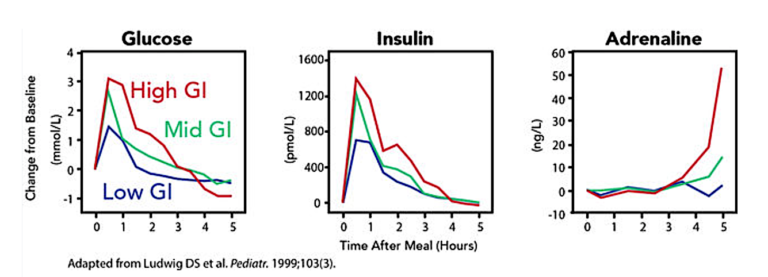In this 2017 piece for Psychology Today, Georgia Ede argues high-glycemic-index foods drive hormonal changes that negatively affect mood and behavior.
Consuming carbohydrate-rich foods leads to a predictable swing in glucose and insulin levels. Glucose levels rise quickly, which leads to an immediate rise in insulin levels to drive glucose levels back down. Simultaneously, insulin affects a variety of other hormones, including estrogen, testosterone, cortisol, and adrenaline. As blood glucose and insulin levels drop, so do the activities of these other hormones — taken together, this leads to the “crash” felt after a carbohydrate-rich meal.

The higher the glycemic index of the meal, the higher the peak and more severe the drop that follows. One study found a glucose-rich drink quadrupled adrenaline levels in healthy teenage boys (1). The average individual eating a diet rich in refined carbohydrates will experience three to six of these spikes each day.

Lower-glycemic-index foods moderate this response. As shown in the figure below (2), trading a high-glycemic-index breakfast (here, sweetened instant oatmeal) for a low-GI breakfast (an omelet with fresh fruit) halves the glucose and insulin response and entirely eliminates the insulin-induced adrenaline spike following the meal.

Thus, trading high-GI for low-GI foods can reduce fluctuations in a variety of hormones over the course of the day, thereby reducing diet-induced mood swings.
Comments on Stabilize Your Mood With Food
Another great piece from Dr. Ede. Her writing is always so easy to digest and the presentation so straightforward that it's a joy to read. And she is spot on with the deleterious emotional and behavioral effects of flooding the bloodstream with glucose. Take this one sentence:
One study found a glucose-rich drink quadrupled adrenaline levels in healthy teenage boysRead that and then think about the legions of adolescent and teenage boys (and girls, for that matter) who routinely belly up to the fast food soda dispenser to fill (and refill) their super-sized, sugar-sweetened, carbonated beverages? The study quoted used the equivalent glucose to what's in just two 12-ounce cans of soda--ie, 24 ounces. That's not even close to what's in the first Big Gulp or SuperSized cup, let alone the refill(s).
Imagine the adrenaline rush spurred by that intake! Anger. Aggression. Fight or flight. Especially in teen and adolescent boys, who are already struggling with the unaccustomed surges in testosterone operating on a not-fully-formed executive center in the brain.
Consider just the 'fight' behavior such an adrenaline flood would trigger and is it any wonder we have an epidemic of 'hyperactivity' and 'behavior problems' among the youth of today? Before prescribing drugs, shouldn't we prescribe a diet of decent food?
Consider further, and more ominously, that following the Parkland school massacre the shooter fled the school and went straight to a nearby mall and purchased a soda and then went to a fast food restaurant.
Great article! A lot of depression, mood swings and mental imbalances may be eliminated by getting rid of the usual suspects - highly addictive sugar and highly processed carbohydrates. Thank you CrossFit!
Agreed - surprises me that more people don't know about this, and if they do why they don't do something about it.
I thought this was a really good easy to read article. I found the below statement pretty interesting, and in general I pulled some good nuggets from reading this article.
insulin is not simply a blood glucose regulator, though even many doctors continue to think of it that way. Insulin is actually a master growth hormone; when it peaks, it puts the body into growth and storage mode. One of the ways it does this is to turn fat-burning enzymes OFF and fat-storage enzymes ON, which is why high-sugar diets can be so fattening.
I agree - super easy article and that line also stood out to me as well!!
Stabilize Your Mood With Food
5